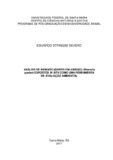| dc.creator | Severo, Eduardo Stringini | |
| dc.date.accessioned | 2018-07-19T21:12:14Z | |
| dc.date.available | 2018-07-19T21:12:14Z | |
| dc.date.issued | 2017-03-24 | |
| dc.identifier.uri | http://repositorio.ufsm.br/handle/1/13862 | |
| dc.description.abstract | Aquatic ecosystems are affected by the use of agrochemicals in agricultural areas near rivers. To evaluate possible impacts, studies with animals that inhabit these ecosystems are needed. In situ exposure is one way of assessing possible damage to ecosystems. The aim of this study was to investigate the use of Rhamdia quelen as a bioindicator through its in situ exposure. Group of 10 fishes were transported and placed in cages at three sites (S1, S2 and S3) of the Vacacaí river in the city of São Gabriel, Rio Grande do Sul. After the exposure period of 96 hours, fish were euthanized and brain, gill, liver and muscle were removed for biochemical assays. Biomarkers of oxidative damage as thiobarbituric acid reactive substances (TBARS) and protein carbonylation (PC), biomarker of neurotoxicity as the acetylcholinesterase enzyme (AChE) and antioxidant parameters such as glutathione s-transferase (GST), superoxide dismutase (SOD), catalase (CAT), antioxidant capacity against peroxyl radicals (ACAP) and non-protein thiols (NPSH) were evaluated. The calculation of the Integrated Biomark Response Index (IBR) was used to aid in the interpretation of the results. There was a decrease in AChE in brain of exposed fishes in the three studied sites (S1, S2 and S3). In addition, it decreased levels of TBARS in the brain and increased PC in the brain, liver and gills in S2 and S3. SOD activity decreased at all site in the gills and CAT increased at S3. The increase in GST was mainly observed in the liver at all three sites. ACAP increased in S3. The IBR calculation showed a higher value in S2, followed by S3 and S1. Rhamdia quelen has been shown to be an excellent bioindicator for use in in situ experiments. The use of biomarkers with the help of the IBR proved to be very useful for the results of the study. | eng |
| dc.language | por | por |
| dc.publisher | Universidade Federal de Santa Maria | por |
| dc.rights | Attribution-NonCommercial-NoDerivatives 4.0 International | * |
| dc.rights.uri | http://creativecommons.org/licenses/by-nc-nd/4.0/ | * |
| dc.subject | Peixes | por |
| dc.subject | Estresse oxidativo | por |
| dc.subject | Ecotoxicologia | por |
| dc.subject | Biomonitoramento | por |
| dc.subject | Fish | eng |
| dc.subject | Oxidative stress | eng |
| dc.subject | Ecotoxicology | eng |
| dc.subject | Biomononitoring | eng |
| dc.title | Análise de biomarcadores em jundiás (Rhamdia quelen) expostos in situ como uma ferramenta de avaliação ambiental | por |
| dc.title.alternative | Analysis of biomarkers in jundiás (Rhamdia quelen) exposed in-situ as an environmental assessment tool | eng |
| dc.type | Dissertação | por |
| dc.description.resumo | Os ecossistemas aquáticos são afetados pelo uso de agroquímicos em áreas agrícolas próximas a rios. Para avaliar possíveis impactos, são necessários estudos com animais que habitam esses ecossistemas. A exposição in situ é uma das formas de avaliar possíveis danos em ecossistemas. O objetivo deste estudo foi investigar o uso da espécie Rhamdia quelen como bioindicador, através de sua exposição in situ. Grupo de 10 peixes foram transportados e colocados em gaiolas em três locais (S1, S2 e S3) do rio Vacacaí na cidade de São Gabriel, Rio Grande do Sul. Após o período de exposição de 96 horas, os peixes foram eutanizados e cérebro, brânquia, fígado e músculo foram removidos para ensaios bioquímicos. Foram analisados biomarcadores de danos oxidativos como substâncias reativas ao ácido tiobarbitúrico (TBARS) e carbonilação de proteínas (PC), biomarcador de neurotoxicidade como a enzima acetilcolinesterase (AChE) e parâmetros antioxidantes como glutationa s-transferase (GST), superóxido dismutase (SOD), catalase (CAT), capacidade total contra peróxidos (ACAP) e tióis não protéicos (NPSH). O cálculo do Índice Integrado de Respostas de Biomarcadores (IBR) foi utilizado para auxiliar na interpretação dos resultados. Houve uma diminuição da AChE no cérebro dos peixes expostos nos três locais estudados (S1, S2 e S3). Além disso, diminuiu os níveis de TBARS no cérebro e aumentou a PC no cérebro, fígado e brânquias em S2 e S3. A atividade da SOD diminuiu em todos os pontos nas brânquias e CAT aumentou em S3. O aumento de GST foi observado principalmente no fígado nos três pontos. ACAP aumentou em S3. O cálculo do IBR mostrou um valor maior em S2, seguido por S3 e S1. Rhamdia quelen mostrou ser um excelente bioindicador para ser usado em experimentos in situ. O uso dos biomarcadores com o auxílio do IBR, mostraram-se bastante úteis para o resultado do trabalho. | por |
| dc.contributor.advisor1 | Loro, Vania Lucia | |
| dc.contributor.advisor1Lattes | http://lattes.cnpq.br/6392817606416780 | por |
| dc.contributor.referee1 | Schuch, André Passaglia | |
| dc.contributor.referee1Lattes | http://lattes.cnpq.br/4932611269622766 | por |
| dc.contributor.referee2 | Oliveira, Guendalina Turcato | |
| dc.contributor.referee2Lattes | http://lattes.cnpq.br/1189036200852586 | por |
| dc.creator.Lattes | http://lattes.cnpq.br/9547938807795364 | por |
| dc.publisher.country | Brasil | por |
| dc.publisher.department | Bioquímica | por |
| dc.publisher.initials | UFSM | por |
| dc.publisher.program | Programa de Pós-Graduação em Biodiversidade Animal | por |
| dc.subject.cnpq | CNPQ::CIENCIAS BIOLOGICAS::BIOQUIMICA | por |
| dc.publisher.unidade | Centro de Ciências Naturais e Exatas | por |



